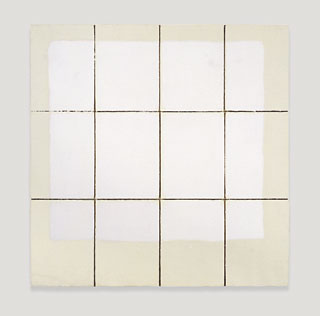|
| |
 |
|


|

Classico IV, 1968. Acrylic on twelve sheets of handmade Classico paper mounted on foamcore, overall: approximately 91 x 89 1/2 inches. Solomon R. Guggenheim Museum, New York, Panza Collection. 91.3845
|

Throughout his career Robert Ryman has attempted to eliminate illusionism and outside references from his work, focusing instead on the fundamental properties of the materials he employs. He has confined himself to the color white, yet disclaims its importance. "It was never my intention to make white paintings," he insisted in a 1986 interview. "The white is just a means of exposing other elements of the painting." These "other elements" include varieties of paint (oil and acrylic) and supports (canvas, paper, and metals), as well as the process of binding them. He investigates the properties of these elements methodically, yet responds spontaneously to the unpredictable exigencies caused by their interaction.
Ryman's Classico IV is one of a series of compositions consisting of multipanel paintings on a specific type of paper called Classico. For each work in the series, Ryman attached a configuration of heavy, creamy white sheets of the paper to a wall with masking tape, painted the sheets with a shiny white acrylic paint, removed the tape when the sheets were dry, mounted them on foamcore, and reattached them to the wall. The built-up paint edge tracing the outline of masking tape and the ripped paper left behind give witness to the process of creation. The various works in the Classico series differ in the organization of paper sheets, the configuration of tape traces, and the painted shape, yet they share an emphasis on the thinness of the support surface in its alignment with the wall and the monumentality conceived as an accumulation of parts.
Just as the Classico works were titled after the type of paper used as a medium, the so-called Surface Veil works were named for the brand of fiberglass upon which the smaller pieces in this group were painted. Surface Veil I, II, and III are among four 12-foot-square paintings from the series that were executed not on fiberglass but on cotton or linen. In each of these works the pigment appears to form a membrane over the support due to the differing degrees of opacity and translucence in the white paint juxtaposed with areas where less of it has been applied, leaving the fabric exposed. These disruptions in the painting's skin often mark the literal pauses between the artist's working sessions.
|
|